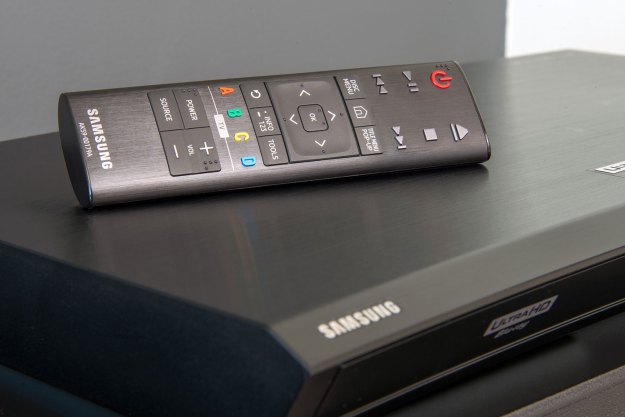
- Best video quality available today
- 4K, HDR, and wide color gamut
- Zippy operation
- Reasonable price for a first-gen device
- Frustrating remote control
- Streaming apps aren’t HDR compatible
If you want the very best picture quality available for your 4K Ultra HD TV – even if it’s not a bleeding-edge set with HDR – then you want an Ultra HD Blu-ray player. Right now, Samsung’s UBD-K8500 is, at least for Americans, the only game in town. We expect competition from Philips and Panasonic to arrive here later this year, but given what we know about pricing, features, and build quality among the three, Samsung’s K8500 will probably still go down as the best overall choice.
The idea of buying another disc-based media player when streaming services like Netflix, Amazon, and VUDU already offer 4K UHD with HDR content might seem like a crazy step back in tech-time. After all, who wants to spend $30 per flick when you can get a wide array of
Those damn discs may be a hassle, but they offer less compressed video and audio than streaming services, and the difference is visible. And if you’re down to be an early adopter, Samsung’s K8500 delivers just about everything you’ll need for a great 4K Home Theater experience.
Out of the box
Given that Ultra HD Blu-ray players represent the next big thing in home video hardware, we were kind of expecting something different when we cracked open the box. Would it be heavier than a normal Blu-ray player? Maybe a little bigger to accommodate heavy-duty hardware? A new disc-loading mechanism? Nope, none of those things. Though, there were a couple of small surprises.
First, there’s no display window on the K8500 – you do everything on the TV. It’s cleaner that way, but we still appreciate an old-fashioned hardware display.
Also, this disc player is curved at the front, keeping with Samsung’s obsession with curved everything, from TVs to sound bars and, now, Ultra HD Blu-ray players.
Finally, the K8500’s remote control requires the use of a flat, disc-shaped CR2032 3V battery instead of a pair of AAA batteries. This keeps it short and slim, but as we’ll explain later, that isn’t to its advantage.
Otherwise, the K8500 is, on the surface, what you’d expect from any mid-level disc player these days: the disc loading tray isn’t particularly solid, nor is it outright flimsy; the back connection panel is as sparse as ever, save a second HDMI port; the chassis is slim and plastic-y enough that you don’t want to put any other equipment on top of it.
Features and Functions
That extra HDMI port will come in handy if you plan on using the K8500 with a home theater receiver purchased anywhere outside of a year ago. Only the newest receivers fully support both HDMI 2.0a and HDCP 2.2; older receivers can’t pass along a full 4K signal with HDR signal. An extra HDMI output lets you run one HDMI cable to the TV for the best picture, and a second to your A/V receiver or sound bar for the best possible sound.
Samsung’s K8500 delivers just about everything you’ll need for a great 4K experience.
Otherwise, setup is about as pain-free as you can ask for. HDMI has advanced to the point that most devices, even those from competing manufacturers, can talk to each other, at least at a basic level. For instance, powering on the K8500 will power on most connected televisions, and we were able to use our TV’s remote control pad to navigate the K8500’s menu and playback features – it’s a two-way street. In some cases, we didn’t realize we were holding the wrong remote, but pressing the correct buttons got the job done anyway, thanks to this device-to-device communication over HDMI.
Samsung doesn’t talk about the K8500’s processor much, but we can tell you it is plenty fast, thank you very much. Boot time from hitting the power button until the player is ready is on par with most Blu-ray players on the market (about 5 seconds), but disc loading is refreshingly quick. We clocked the player at 16 seconds from the time we pressed play until the first frame of Deadpool. Even the Smart Hub interface, while not nearly as fun or easy to use the Tizen interface found in Samsung’s smart TV’s, serves up frequently used apps like Netflix, Amazon, Hulu, VUDU, and Plex with expediency, and in 4K when available.
The K8500 has a few less-useful features such as screen mirroring (your 4K TV likely does that already), a painfully slow and awkward web browser you should never try to use, and CD ripping. The player will handle 3D Blu-ray discs just fine, but as a reminder, the Ultra HD Blu-ray disc format does not support 3D.
There’s precious little the K8500 can’t do. Perhaps the only real concern is that the player can’t play SACD or DVD Audio discs, though we don’t suspect this will be a problem for most folks. Also, the apps on board support 4K, but not HDR – still, you’re probably better off with your TV’s built-in apps anyway.
Oh, and in case you were wondering, the K8500 can be connected to a 1080p TV and still work, but it won’t look any better than a standard Blu-ray.
Performance
The Samsung UBD-K8500 is the best Ultra HD Blu-ray player we’ve used, but that’s technically because it’s the only one we’ve used so far. We expect Panasonic’s forthcoming player will deliver a little more wow factor in the picture quality and audio quality departments, plus a few niche features, but at twice the cost. Meanwhile, Philips’ similarly priced, ultra-compact player probably won’t offer as friendly a user interface, and we don’t expect any significant picture improvements.
Even if Philips does surprise us, though, it’s hard to imagine needing much more from an Ultra HD Blu-ray player. Our experience with the K8500 was overwhelmingly positive. After connecting the player to five different next-gen 4K TVs – four of which were HDR capable – we can honestly say it’s hard to imagine the average consumer needing much more out of an Ultra HD Blu-ray player. Samsung simply ticked all the right boxes.
Our biggest complaint is the remote. Samsung, we’re sorry, but this remote can go to hell. It’s too small with tightly grouped D-pad buttons and isn’t backlit. Because of its closely-positioned buttons, we often found ourselves pressing ‘OK’ rather than the ‘up’ arrow, resulting in a lot of waiting around while an app loaded or a disc stared playing before we could backtrack and try again. Give us a larger remote with larger buttons and a backlight for easier handling in the dark.
As a player, the K8500 gets the job done, and gets it done well. We’re in no hurry to get a replacement in because we’re enjoying watching 4K HDR content in its ultimate form. And it really does look outstanding with the right discs.
Content is king
Ultimately, the K8500 is only as good as the content it plays, and not all 4K UHD with HDR discs are created equal. Most of the films coming out on Ultra HD Blu-ray right now come from 2K “intermediates” that have been up-scaled to
Still, a film that has been upscaled to 4K from 2K can look pretty incredible if the HDR metadata is done right, and the film’s colorist takes into account the expanded color expression capabilities. One of the better examples of a film that was downscaled to 2K from
Perhaps the best mainstream example of an Ultra HD Blu-ray yet is the recently released Deadpool, which was reportedly sourced from a 4K master. Here, high levels of detail combine with HDR and expanded color for one of the best at-home cinematic viewing experiences we’ve ever had. If there’s one disc you should pick up when ordering the K8500, it’s the 4K Ultra HD copy of Deadpool. Your friends will be impressed.
Conclusion
To get the best of what the K8500 has to offer, you need to have a lot of pieces in place. You’ll want the best 4K Ultra HD discs, and you’ll need a next-gen 4K TV with solid HDR processing, and either exceptionally deep blacks (OLED!) or an LED TV with a really solid backlighting system for bright highlights without all the halo that can come with them. Put all of that together, and you have the best at-home movie watching experience available to consumers today – well, under the $10,000 price point, anyway.
If your TV doesn’t have HDR, the K8500 still provides the best picture quality source in terms of resolution of detail and smooth color gradations. Still,
If you don’t have a 4K TV yet, but you want to have the best source available when you get one, then you could pick up the K8500 now and start racking up the new discs – it’ll work with your TV. But, we’d advise just waiting until you have a new TV. You can still buy the discs, because they all come with a standard Blu-ray in the case.
We’re holding off on awarding the K8500 our Editor’s Choice award until we’ve seen the competition, but we still recommend it, mostly for early adopters who want to get the best picture quality available for their hot new 4K HDR TV.
Editors' Recommendations
- Samsung’s new 98-inch DU9000 4K TV is just $4,000. Can it beat TCL and Hisense?
- The best 4K Blu-ray players for 2024
- The best 8K TVs for 2024: from Samsung, LG, and Sony
- Samsung takes on TCL with 98-inch 4K TV that costs just $8,000
- Samsung S95C OLED hands-on review: it’s time to get excited










